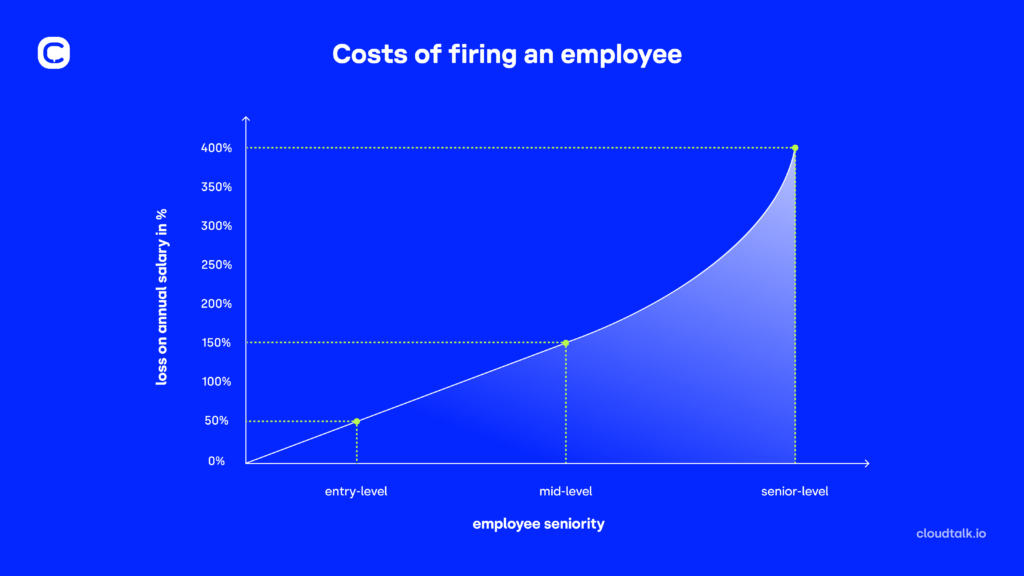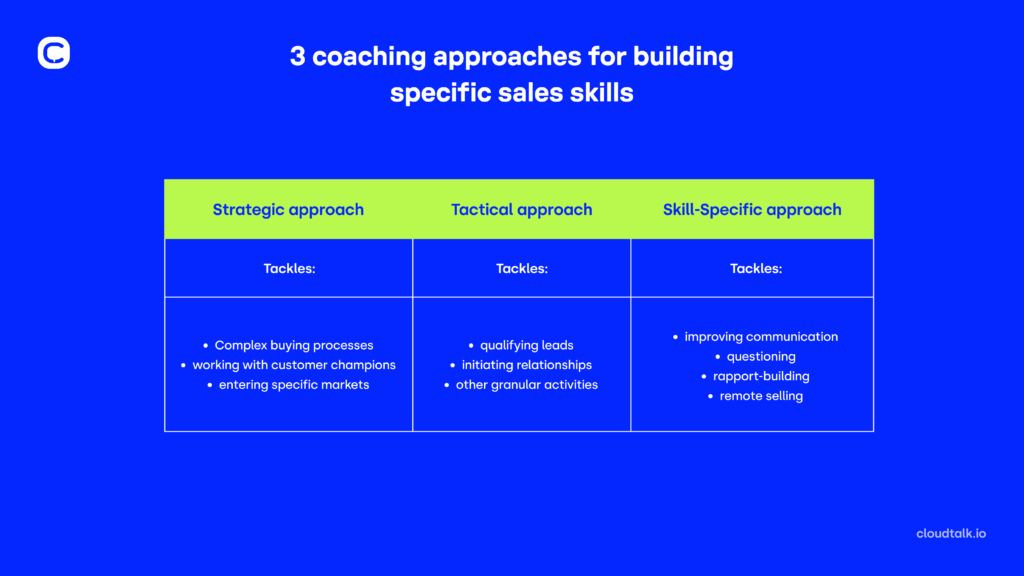
Gallup found that burnout can cost the average company $20,000 for every $100,000 in employee salaries. But layoffs aren’t the answer.
Sales are a roller coaster. A deal won sends spirits and finances sky-high, while a loss brings you crashing back down to earth. Unfortunately, only 2% to 5% of leads ever convert, so losses are far more common than wins. And that takes a toll.
Some surveys suggest that 67% of salespeople are close to burnout at any given time. If you think poor sales performance has a negative impact on your mental health, just consider how your reps must feel after getting the cold shoulder every day.
But with money at stake, you want to make the problem disappear ASAP. So, you conclude it’s probably the Sales team’s fault and start considering lay-offs.
SPOILER ALERT: That’s not a great idea.
Below, we’ll show you why that is, as well as what you’re actually supposed to do.
Why Burnout Costs Companies 190 Million Each Year
Burnout is often called “the Silent Killer”, and not without reason. It wreaks havoc not only on your employees but your entire company. In fact, it can cost you upwards of $2,469 per rep per year.
And if you don’t believe us, you can run the numbers yourself with the Mental Health Cost Calculator.
That number stems from disengaged employees having 37% higher absenteeism, 18% lower productivity, and 15% lower profitability. And now the scary part – only 21% of employees consider themselves “highly engaged”.
That’s a scary thought, especially when you extrapolate those numbers to your entire sales team. But being afraid isn’t exactly proactive, so instead, you should ask yourself…
“If burnout is so silent, how do I even know my team is suffering?”
What Does Burnout In Sales Look Like?
Sales isn’t the same as your other teams. First and foremost, because their burnout is the most directly tied to your revenue. But it’s also because it doesn’t manifest the same way.
Internally, sales burnout causes:
- Disengagement at work and in personal life,
- Loss of interest in daily activities,
- Spirals of negative thoughts,
- Constant exhaustion.
- Feelings of defeat,
- No confidence.
Externally, sales burnout manifests as:
- Lack of motivation,
- Poor performance,
- Low productivity,
- Absent-mindedness,
- Frequent sick leaves,
- Unwillingness to change,
- No interest in self-improvement.
Burnout Is About Your Workplace, Not Your People
…is what Harvard Business Review said in a recent study. Stanford agreed, and so did the Gallup survey that found that the five most common reasons for burnout were organizational. But before we get to those, let’s consider everything at play here.
The causes of burnout can be:
1. Personal
- Personal predispositions such as character, perfectionism, and positive affect;
- Personal situations, stress, lack of support networks, and job position fit;
- Coping mechanisms and the ability to self-regulate emotions.
2. Team-induced
- Underlying team structures, including size, communication channels, and processes;
- Atmosphere, including how freely people can communicate and to what degree they can self-realize;
- Lack of tools or resources.
3. Organizational
- Unfair treatment at work;
- Unmanageable workload;
- Lack of clear roles;
- Lack of support and communication with their manager;
- High time pressure;
- Level of transparency within the organization;
- Availability of benefits and vacations.
The Valley Of Despair: How Sales Teams Burn Out
You should also keep in mind that you can never completely get rid of burnout. You can take steps to limit its development and eventually overcome it. However, you’ll still experience its adverse effects at least once a quarter.
The valley of despair refers to the low point in the emotional journey that many individuals go through when faced with new challenges.
– Anthony Nicks, Founder & CEO of Transformative Sales Systems
Anthony Nicks outlined the cycle of burnout sales teams go through in his article on the Valley of Despair. Stemming from the concept of the “emotional curve”, he identified 5 stages:
- Uninformed Optimism/Ignorance:
This stage begins with a new initiative, often at the beginning of a month or quarter. At this stage, employees are excited about the endeavor but aren’t yet fully aware of all the challenges that lie ahead. - Informed Pessimism:
As the team encounters roadblocks and difficult challenges, doubt and skepticism start to spread. - Valley of Despair:
Marks the emotional low point where the team (and organization) feels completely overwhelmed, discouraged, and tempted to abandon the initiative. - Informed Optimism:
With persistence, the team begins to overcome their challenges and make steady progress. As new effective strategies emerge, agents begin to regain their composure and see a light at the end of the tunnel. - Success and Fulfillment:
The challenges are managed effectively at this stage, and the new initiative or project starts to yield results.
When applied to Sales, the cycle usually begins with the unveiling of a new product or service. The agents feel generally optimistic and believe in what they’re going to sell your prospects.
However, doubt, anxiety, and discouragement arise if leads remain unenthusiastic about the proposition and refuse to convert. So, what are the strategies that’ll break them out of their Valley of Despair?
One Easy Way To Lose <400% Of Your Employees’ Salary
At the beginning of the article, we mentioned that firing your sales team wasn’t the solution. But if you’ve remained unconvinced until now, let us give you a few reasons why. Tim Sernett, Founder & CEO of Financial Optics, outlines the 5 downsides of letting your employees go.
- Loss of Productivity:
Responsibilities don’t just disappear along with the employee. Some tasks will fall through the cracks, and you’ll lose a valuable resource to deal with the workload. - Overworked Agents:
The remaining reps will need to pick up the slack after the vacancy, which is likely to lead to faster burnout, missed deadlines, and overall poor performance. - Loss of Experience and Knowledge:
The person who left knew your culture, processes, and people. That’s not something you can readily replace. Even worse is if they had any “tribal knowledge” – best practices and know-how not written down and only known by employees. - Training Costs:
Once you find someone to join your team, you’ll have to assign them a mentor or double-check everything they do. But most SMBs don’t have the resources necessary, so it’ll come at the cost of other initiatives and salaries. - Interview Costs:
Assuming you don’t have the finances to hire a headhunting firm or prefer to do things your way, you’ll have to take the time out of your (and others’) busy schedules to interview and evaluate potential candidates. With the same consequences.
Doesn’t sound like fun, right? And we haven’t even mentioned the final price tag. According to rough estimates, after everything is said and done, firing an employee can cost you:
- Entry-Level: 30% – 50% of their annual salary,
- Mid-Level: <150% of their annual salary,
- Senior-Level: <400% of their annual salary.

But that’s not to say you should never lay anyone off. If an agent consistently underperforms, the ROI on their replacement can be rather short and well worth the effort. However, if your entire team falls short, chances are you can’t afford to fire them all.
If everyone’s underperforming, it’s likely not the team’s fault. It’s either you or the burnout.
…Or both. Regardless, let’s discuss how you can fix it.
Sales Burnout Treatments (Cold Press Not Included)
Experts suggest various treatments for sales burnout – some more effective than others. Here are a few to consider:
- Acknowledge and Normalize the Feelings:
58% of agents feel there’s a stigma around discussing mental health. So, your first step should be to speak with your agents about what they’re going through, acknowledge it’s a natural part of the sales process, and reassure them you will find a solution. - Encourage Peer Support:
Next, you’ll want to reinforce the safety nets a collaborative environment offers. Whether you leave it free-form or create a peer support group for discussing work-related challenges is up to you. Just don’t underestimate the value of teamwork. - Shift the Mindset:
If you want to take some weight off your agents’ shoulders, you need to fundamentally change how you respond to bad news. Instead of harsh words and threats, focus on embracing a growth mindset – seeing shortcomings as opportunities to improve. - Set Realistic Expectations:
57% of agents feel their workload is unmanageable. If this is a common feeling in your sales team, too, you should reconsider how you set goals. Instead of attributing value only to total sales, try assigning processual KPIs (i.e., calls made, demos given, etc.).
Research suggests that poor relationships with direct managers cause 75% of turnover. Often, this results from managers being incentivized to prioritize short-term gain over long-term sustainability improvements. - Celebrate Small Wins:
Positive reinforcement is a powerful tool. By redirecting your agents’ focus from past shortcomings to recent successes – no matter how small, their confidence and enthusiasm are sure to come back. - Make Room for Self-care:
A healthy sleep schedule, exercise, and regular breaks from work are excellent preventive methods against burnout. But you need to give your employees room to engage in them before you see any improvement.
How CloudTalk Achieved Unprecedented Sales Growth
It’s one thing to fight burnout by treating the symptoms. But if you want to help your sales reps perform as well, and even better than before, there’s only one cure – good coaching.
Here are just a few reasons why:
- 60% of agents say they’re more likely to quit if their manager is a bad coach;
- Effective usage of sales coaching software increases annual performance by 7%;
- 55% of sales reps lack the necessary skills to succeed.
Keeping these insights in mind, we wanted to dig deeper into how CloudTalk’s sales team approaches effective coaching. And our Account Executive Dominika was kind enough to give us the scoop.
3 CloudTalk Tips For Maximizing Sales Coaching Efficiency
To let you peak into CloudTalk’s processes, we interviewed our star Account Executive Dominika. We asked her to share a bit of her sales coaching experience.
Here’s what she has to tell you:
- Dominika, what would you say has been the most valuable tool for addressing low sales in our team?
“To address low performance, we use automation tools like Modjo to carry out detailed call analysis. This allows us to access a step-by-step breakdown of each call, including the call transcript, specific topic, and other vital information.
Based on these insights, managers can identify mistakes, clearly explain them to the underperforming rep, and plan a strategy to avoid them in the future. This should include tips on communicating better, how often to reach out, and more.”
- What’s the single most useful strategy managers can do to help coach their sales teams efficiently?
“A great one is to go through the entire process of one deal – from first contact to the last touchpoint. Ideally, you’d want to do this regularly with each employee at least once a year.
For example, I went through this process recently. We lost a deal but didn’t give up. Our CRO sat down with me and helped me by leading me through the sales process step by step. He even gave me feedback on my emails.
As a result, we ended up closing the deal. Not only that, I’ve since turned the 60-email-long thread we used into my personal sales template. It gives me invaluable advice on how to communicate with leads, when to push, and when to slow down.”
- Is there anything else you would like to recommend managers do for their sales team throughout coaching to achieve the best results possible?
“When there’s something the reps do wrong, be there for them. Be their guide when they’re lost. If you make them a part of the process and give them actionable advice on what to do, they’ll listen and know how to do things right. There’s no better way to learn.”
Sales Coaching Methods You (Probably) Aren’t Using
Of course, our approach isn’t perfect, and we don’t have all the answers. But others might. Here are two more methodologies to consider adding to your smart coaching process.
Vary Your Coaching Approach
Like in sales, not all coaching strategies are created equal. Some fit specific situations better than others, and there’s a time and place for everything. Mike Kunkle, the author of “The Building Blocks of Sales Enablement”, recommends you leverage 3 coaching approaches.
- Strategic: Focus on creating and executing effective strategies. Identify clear objectives, analyze current situations, and work with your agents to develop actionable plans.
In sales, this approach can tackle complex buying processes, working with customer champions, and entering specific markets. - Tactical: View the sales process through a narrower lens. Focus on aspects like qualifying leads, initiating relationships, and other granular activities.
- Skill-Specific: Instead of the sales process, focus on the employee’s skill set. Offer feedback and resources on improving communication, questioning, rapport-building, remote selling, and others.

It is crucial to correctly analyze a situation, identify the problem’s source, and choose an appropriate strategy to fix it. And, importantly, much more effective than spending hours trying to find a one-size-fits-all solution.
Explore how to support your team further with these call center tips.
Pick Your Fights
Just like coaching strategies, sales reps aren’t all created equal, either. According to Shelley Cernel, the VP of Marketing at Thirty Capital, you need to use your limited resources on the ones that’ll benefit from them the most.
Rather than focusing on the leaders and the laggards, coach the middle two-thirds of reps who have both the room for improvement and the incentive to be top performers.
– Shelley Cernel, VP of Marketing at Thirty Capital
An HBR study found that even the best coaching in the world only has a marginal effect on the highest and lowest performers. This may seem counterintuitive, as you’d expect the lowest 20% to have the most to gain. But that’s not the case, they’re just a poor fit for the role altogether.
If you want to achieve the best results and get a return on your investment as quickly as possible, nurture the agents that are just average. After all, they’re the most numerous. That means collectively, they have the most room to grow.
Where There’s Smoke…
Despite all the progress we like to think we have made in terms of improving employee health and productivity as an industry, there are clearly some pieces still missing. And so we urge you, don’t get hasty when it comes to applying quick fixes to underperforming sales.
According to HBR, wellness programs don’t work, and as we’ve seen, neither do lay-offs. So, if you see your numbers tanking, keep a cool head and investigate your team carefully.
Because, as they say, where there’s smoke, there’s fire.
And we don’t want you to get burned.
Sources:
- Gallup: How To Prevent Employee Burnout
- Databox: Lead Conversion Rate: What Is Good And How To Optimize It?
- Deloitte: Mental Health & Employers
- Sales Health Alliance: Mental Health Cost Calculator
- Achievers: 9 Employee Engagement Statistics That Matter
- Harvard Business Review: Burnout Is About Your Workplace, Not Your People
- Gallup: Employee Burnout Part 1: The 5 Most Common Causes
- Stanford Social Innovation: Burnout From An Organizational Perspective
- Anthony Nicks: Valley Of Despair: Impact on Sales & Strategies To Overcome
- Tim Sernett: How Much Does It Cost To Fire An Employee?
- Thrive Global: The State of Burnout in the Sales Industry
- Gallup: Turning Around Employee Turnover
- HubSpot: The Ultimate Sales Coaching Guide
- LinkedIn: Mike Kunkle
- LinkedIn: Shelley Cernel
- Zendesk: How To Coach Reps to Succeed in 2023
- Harvard Business Review: The Dirty Secret of Effective Sales Coaching
- Harvard Business Review: What Wellness Programs Don’t Do For Employees
















